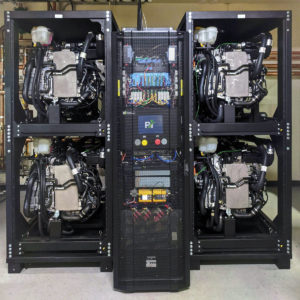
Microsoft tests hydrogen fuel cells for backup power at datacenters
In a worldwide first that could jumpstart a long-forecast clean energy economy built around the most abundant element in the universe, hydrogen fuel cells have powered a row of datacenter servers for 48 consecutive hours, Microsoft announced Monday.
The feat is the latest milestone in the company’s commitment to be carbon negative by 2030. To help achieve that goal and accelerate the global transition away from fossil fuels, Microsoft is also aiming to eliminate its dependency on diesel fuel by 2030.
Diesel fuel accounts for less than 1% of Microsoft’s overall emissions. Its use is primarily confined to Azure datacenters, where, like at most cloud providers around the world, diesel-powered generators support continuous operations in the event of power outages and other service disruptions.
“They are expensive. And they sit around and don’t do anything for more than 99% of their life,” said Mark Monroe, a principal infrastructure engineer on Microsoft’s team for datacenter advanced development.

Lucas Joppa, Microsoft’s chief environmental officer, is Microsoft’s representative on the Hydrogen Council, a global initiative of leading energy, transport and industry companies to spur the hydrogen economy. Credit: Roderigo De Medeiros
In recent years, hydrogen fuel cell costs have plummeted to the point that they are now an economically viable alternative to diesel-powered backup generators.
“And the idea of running them on green hydrogen fits right in with our overall carbon commitments,” Monroe said.
What’s more, he added, an Azure datacenter outfitted with fuel cells, a hydrogen storage tank and an electrolyzer that converts water molecules into hydrogen and oxygen could be integrated with the electric power grid to provide load balancing services.
For example, the electrolyzer could be turned on during periods of excess wind or solar energy production to store the renewable energy as hydrogen. Then, during periods of high demand, Microsoft could start up the hydrogen fuel cells to generate electricity for the grid.
Hydrogen-powered long-haul vehicles could pullup at datacenters to fill their tanks.
“All of that infrastructure represents an opportunity for Microsoft to play a role in what will surely be a more dynamic kind of overall energy optimization framework that the world will be deploying over the coming years,” said Lucas Joppa, Microsoft’s chief environmental officer.
To further explore how Microsoft can leverage its investment in hydrogen fuel cells and related infrastructure, the company today named Joppa as its representative on the Hydrogen Council, a global initiative of leading energy, transport and industry companies to spur the hydrogen economy.
Scientists have already proved that hydrogen fuel cells can be used to generate greenhouse gas-free energy from the most abundant element in the universe, Joppa noted.
“We know how to do it,” he said. “The council exists because we don’t necessarily know how to scale the generation of hydrogen, transportation of hydrogen, supply of hydrogen and then consumption of it in the various ways that we would like to. There’s still tons of work that needs to be done.”
Replacements for diesel

Mark Monroe, a principle infrastructure engineer on Microsoft’s team for datacenter advanced development, is leading a project exploring the potential of hydrogen fuel cells to power backup generators at datacenters. Credit: Mark Monroe/Microsoft.
Microsoft strives to provide Azure datacenter customers “five-nines” of service availability, which means that the datacenter is operational 99.999% of the time. Backup generators are fired up during power grid outages and other service interruptions.
“We don’t use the diesel generators very much,” Monroe said. “We start them up once a month to make sure they run and give them a load test once a year to make sure we can transfer load to them correctly, but on average they cover a power outage less than one time per year.”
Microsoft is researching replacement technologies to diesel that would maintain or improve service availability and sees promise in hydrogen fuel cells and batteries, explained Brian Janous, general manager of Microsoft’s team for datacenter energy and sustainability strategy.
“The work that the team is doing today is really looking at trying to evaluate the feasibility of different solutions,” he said.
Batteries already supply short-term backup power, filling the 30-second gap between an outage on the grid and the time it takes to power up the diesel generators. More advanced batteries have longer durations.
“If you get to a scenario where the durations that you require are of such a length that batteries cease to be effective, that’s when you would spill over into looking at something like fuel cells,” Janous said.
Proof of concept

Power Innovations built a 250-kilowatt fuel cell system to help Microsoft explore the potential of using hydrogen fuel cells for backup power generation at datacenters. In a proof of concept, the system powered a row of datacenter servers for 48 consecutive hours. Credit: Power Innovations.
The seed for using hydrogen fuel cells for backup power was planted in spring 2018, when researchers at the National Renewable Energy Laboratory in Golden, Colorado, powered a rack of computers with a proton exchange membrane, or PEM, hydrogen fuel cell. Monroe and his colleagues were on hand for the demonstration.
“We got intrigued because we knew that they were using an automotive fuel cell,” Monroe said. “An automotive fuel cell has the reaction time like a diesel generator does. It can turn on quickly. It can be ready for a full load within seconds. You can floor it, let it off, let it idle.”
PEM fuel cells combine hydrogen and oxygen in a process that produces water vapor and electricity. Automotive companies are developing the technology to power cars, trucks and other vehicles. After the demonstration, Microsoft started thinking about using fuel cells for backup power at datacenters.
Monroe’s team procured a 250-kilowatt fuel cell system, which is sufficient to power a full row, on the order of 10 racks, of datacenter servers. Tests began at Power Innovations, the system developer, outside Salt Lake City in September 2019. The system passed the 24-hour endurance test that December; the 48-hour test this June.
“It is the largest computer backup power system that we know that is running on hydrogen and it has run the longest continuous test,” Monroe said.
The next step for the team is to procure and test a 3-megawatt fuel cell system, which is on par with the size of diesel-powered backup generators at Azure datacenters.
Fuel cell explorations

Brian Janous is general manager of Microsoft’s team for datacenter energy and sustainability strategy. His team is exploring replacement technologies to diesel powered backup generators. Credit: Scott Eklund/Red Box Pictures.
Even before that 2018 demonstration, Microsoft had been looking at ways to use fuel cells. The company started to explore fuel cell technology in 2013 with the National Fuel Cell Research Center at the University of California, Irvine, where they tested the idea of powering racks of servers with solid oxide fuel cells, or SOFCs, which are fueled by natural gas.
“They have the ability to make their own hydrogen out of the natural gas feed that they get,” Monroe explained. “They take natural gas, a little bit of water, they heat it up to 600 degrees C, which is the temperature of a hot charcoal fire.”
That’s hot enough for a process called steam methane reformation that generates a stream of hydrogen atoms for electricity generation.
Microsoft has continued to explore the potential of SOFC fuel cell technology to provide baseload power, which could free datacenters from the electric power grid while making them 8 to 10 times more energy efficient. For now, though, the technology remains too expensive for widespread deployment.
The SOFC process also produces carbon dioxide, which is another reason that Microsoft is exploring PEM fuel cells, Monroe noted.
In addition, estimated costs for PEM fuel cell systems for backup power generation at datacenters have fallen more than 75% since the demonstration at the National Renewable Energy Laboratory. If the trend continues, in a year or two the capital costs of fuel cell generators could be price competitive with diesel generators.
The increased production of fuel cells to meet the demand from the datacenter industry could potentially further drive down costs, he added.
“We very much see ourselves as a catalyst in this whole hydrogen economy,” Monroe said.
Hydrogen economy
From Microsoft’s perspective, other parts of this economy include infrastructure to procure, store and maintain a sufficient supply of green hydrogen to power the backup generators for 12 to 48 hours, which is standard in the industry to enable those “five nines” of service availability.
For example, for 48 hours of backup power generation, each datacenter would require up to 100,000 kilograms of hydrogen to fuel the backup generators for an extended power outage, Monroe said.
Internal conversations about how to secure this infrastructure have led to discussions about the role Microsoft could play in spurring the hydrogen economy, Janous noted.
“What if you could take all of these assets the datacenter has and integrate them into the grid in a way that helps to further accelerate decarbonization of the grid more broadly rather than just a point solution for the datacenter itself,” he said. “That’s where I think all of this gets interesting.”
Top image: Microsoft used hydrogen stored in tanks on trailers parked outside a lab near Salt Lake City, Utah, to fuel hydrogen fuel cells that powered a row of datacenter servers for 48 consecutive hours. Credit: Power Innovations.
Related:
- Read: Aiming for more than just net zero
- Learn more about Microsoft’s commitment to be carbon negative by 2030
- Check out Microsoft’s earlier work with solid oxide fuel cell technology
- Read: Under the sea, Microsoft tests a datacenter that’s quick to deploy, could provide internet connectivity for years
- Listen to a Microsoft Research Podcast with Lucas Joppa
John Roach writes about Microsoft research and innovation. Follow him on Twitter.
